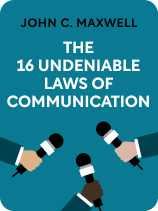

This article is an excerpt from the Shortform book guide to "The 16 Undeniable Laws of Communication" by John C. Maxwell. Shortform has the world's best summaries and analyses of books you should be reading.
Like this article? Sign up for a free trial here.
Do you know how to write an effective speech? When and how should you use stories and visual aids? How should transitions be structured?
According to John C. Maxwell, even experienced speakers prepare extensively before speaking in front of an audience. Of course, preparation includes the actual writing of your speech. Maxwell describes several steps for turning your research and preparation into a memorable message.
Continue reading for Maxwell’s expert recommendations that you can put to work for you right away.
How to Write an Effective Speech
Maxwell shares practical advice on how to write an effective speech that will make a lasting impression. He outlines a process that entails three steps and then discusses ways to use visuals and stories. Finally, he shares advice on how to make sure your message is simple and clear.
1. Develop your thesis. This should be a single sentence that sums up your message. Maxwell writes that you must clarify your thesis before communicating anything—if you don’t know your thesis, your audience will have an even harder time understanding it.
(Shortform note: Once you have an idea of what your thesis is, refine it by considering four criteria: clarity, coherence, consistency, and credibility. To improve clarity, replace or remove confusing or vague words from your thesis statement. To check for coherence, evaluate whether your thesis clearly connects to the main points you wish to present. To have consistency, adjust your thesis to match the purpose and tone of your presentation. And lastly, to ensure credibility, assess whether you have the evidence to back up your thesis statement.)
2. Research and plan out your talking points. Create a basic outline of your main points and gather supporting material such as data, stories, and ideas. Maxwell recommends you experiment with ways to organize your main points so that the audience sees how they’re all connected: Consider numbering them, arranging them in an acrostic (a word that has each of its letters spelling out a new word or sentence), or using a common word in each of your major points. Once you have your basic organization, you can then sort the supporting material you’ve gathered under the relevant points.
(Shortform note: In Talk Like Ted, Carmine Gallo recommends you use a message map to plan out your presentation. This one-page template helps you visualize and structure your content in a way that’s clear and easy for your audience to follow. To create a message map, first draw an oval at the top of a piece of paper and write down the main point of your presentation as a concise headline. Then, draw three arrows extending from your main point and write your sub-points beneath the arrows. Under each sub-point, jot down supporting information such as stories or quotes. According to Gallo, you should include no more than three sub-points because the human brain can only process three ideas at once.)
3. Plan your transitions. Once you have your main points in order, plan out how you can shift smoothly from one point to the next. At the start of your presentation, don’t just jump into your thesis, but find a way to lead into it. Consider using a quote, telling a story, asking a question, or simply taking time to connect with the audience. As you progress through your presentation, Maxwell suggests using various cues to indicate when you’re transitioning to a new point. Make a note to pause, walk to a different spot in the room, change your facial expressions, or vary the volume, speed, or tone with which you speak.
(Shortform note: Other experts explain the importance of transitions: They help your audience relax and focus on your message. Unlike when reading, people can’t go back and review the previous points you made in your speech. If you don’t signal topic changes with transitions, your listeners will focus more on keeping up with you than truly listening to what you have to say. Eventually, they may get tired of trying to follow along and stop listening. If instead, audiences sense that your presentation is well-structured, they can relax, trust that you’ll effectively guide them through your points, and become more attentive to your message.)
Engage Your Audience With Visuals and Stories
When creating your message, Maxwell suggests you use visual imagery and storytelling to keep your audience engaged as you speak. These strategies make it easier for your audience to grasp your arguments and remember them.
First, incorporate visuals into your presentation. You can use body language, metaphors, or actual visual aids like physical props and imagery to help illustrate your ideas. Maxwell explains that people remember images better than words and that most people are visual learners.
(Shortform note: Some experts argue that you should engage multiple senses in addition to vision. In Talk Like Ted, Carmine Gallo argues that activating multiple senses makes a presentation more memorable to audiences than engaging just one of their senses. He suggests you aim to engage your audience’s hearing and touch as well. To engage their hearing, consider incorporating other voices apart from your own by playing a video or having a guest speak. To engage their touch, if you don’t have anything physical to pass around, ask your audience to imagine what something feels like, such as the tickle of a grassy field.)
Second, Maxwell suggests you tell the audience a story to make your points more accessible and engaging. He explains that people remember stories because we naturally use stories to make sense of our lives. You can tell stories from your personal life or share the stories of others, but make sure that they’re relevant to your audience and the points you’re trying to make.
(Shortform note: In How Highly Effective People Speak, Peter D. Andrei specifically recommends telling a story about a single person. This allows audience members to better imagine themselves in the person’s shoes, which engages them emotionally. After you share a story about one person, you can then explore the broader implications of your topic, like how it affects your audience. For example, if you’re discussing the importance of mental health among college students, you could talk about the struggles of a single student before introducing statistics about how prevalent the issue is.)
Simplify Your Message
When writing your message, Maxwell recommends you simplify your ideas to be clear, concise, and memorable so that your audience can better understand and remember them.
First, to simplify your message, use language that an eighth grader can understand, and trim excess information that might distract from your main points. Many speakers are afraid of being simplistic, but Maxwell argues that “simple” doesn’t mean you’re watering down your ideas or glossing over complex topics. Instead, “simple” means making your content practical and easy for your audience to understand rather than trying to sound impressive.
| Additional Tips on Simplifying Your Message Other experts agree that being simple is key to making an effective presentation. In The Bezos Blueprint, Carmine Gallo shares additional tips on how to simplify your message. Use simple words and sentences. Gallo recommends you choose words of Anglo-Saxon origin over those of Latin or Greek origin because Anglo-Saxon words tend to be shorter and more direct—for example, use “help” instead of “facilitate.” Use active language. Gallo suggests you write your speech in an active voice rather than passive because active language tends to be more concise and assertive. For example, you should say: “People should give compliments more often” rather than “Compliments should be given more often.” Avoid hedging and qualifying language. Gallo suggests you not only cut unnecessary information as Maxwell suggests, but he also advises you to eliminate hedge words and qualifiers. These are words or phrases that soften your statements, making them sound more hesitant. For example, instead of saying, “In general, our product was rather successful,” you should say, “Our product was successful.” |
Second, make your message memorable by coming up with unique and catchy phrases. Try putting a spin on well-known sayings, such as changing “Practice makes perfect” to “Practice makes character.”
(Shortform note: Daniel Pink suggests another way to make your message memorable: Boil your message down to a single word. When people associate a single word with your message, anytime they hear that word, they’ll be reminded of your presentation.)

———End of Preview———
Like what you just read? Read the rest of the world's best book summary and analysis of John C. Maxwell's "The 16 Undeniable Laws of Communication" at Shortform.
Here's what you'll find in our full The 16 Undeniable Laws of Communication summary:
- The secrets to becoming a confident and effective communicator
- How anyone can master public speaking, no matter how nervous they get
- How to write a clear and engaging speech






